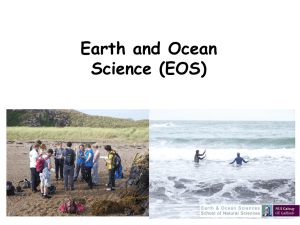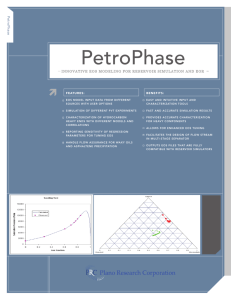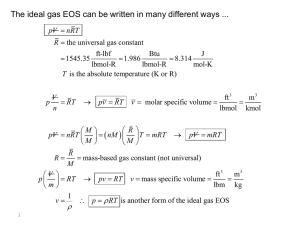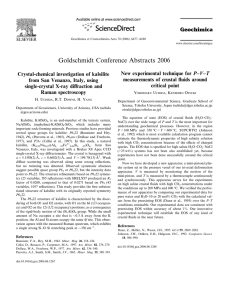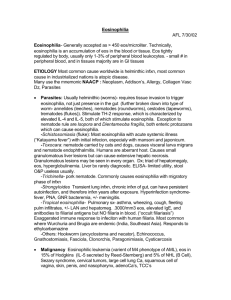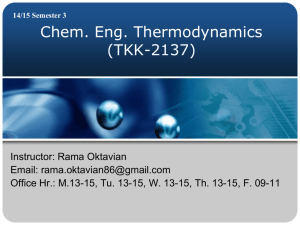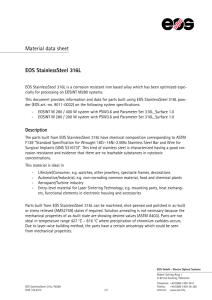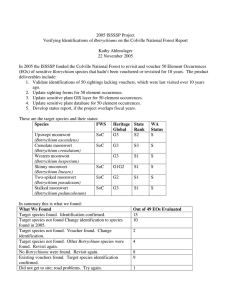Equations of state (EOS)
advertisement
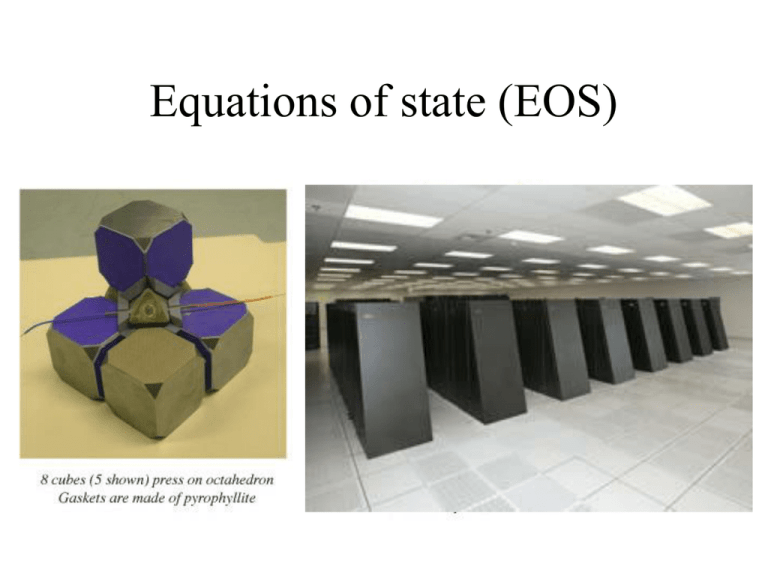
Equations of state (EOS) An EOS is a relation between P, V and T. The EOS known to everybody is the ideal gas equation: PV=nRT Important thermodynamic definitions: Incompressibility: KS=-V(P/V)S KT=-V(P/V)T Thermal expansivity =1/V(V/T)P Grüneisen parameter (P/T)V=CV/V An important relation is KS/KT=1+T Isothermal EOS i.e. How does the density vary with depth (pressure)? If we assume K is a constant P = -K (ΔV/V) for small ΔV i.e. Hooke’s Law But minerals undergo large volume strains in the Earth For large ΔV, integrate dP/K=d/ with constant K, we get /0=exp(P/K0) This is different from observations! - As density increases, atoms get closer together - Repulsive forces are non-linear functions of interatomic distances i.e. the increase of density with depth becomes more difficult with increasing compression. K must increase with increasing P Murnaghan EOS (empirical) • Murnaghan (1967) : K=K0+K’P • In other words P=(K0/K0’)[(V/V0)K0’-1] • Good for compressions up to ~10% • Commonly assume K’=4 Birch EOS (empirical) • Birch (1961) observed for crustal rocks: • Vp=a(m)+b m is the mean atomic weight •Leads to ‘Birch’s Law’… Schreiber & Anderson, Science 1970 Birch-Murnaghan EOS (finite strain theory) Eulerian strain: =u/x-1/2(u/x)2 V/V0=0/=(1-2)-3/2=(1+2f)-3/2 Helmholtz free energy: F=af2+bf3+cf4+… P=-(F/V)T K 2nd (linear elasticity), 3rd, 4th order BirchMurnaghan EOS Some remarks: The assumption is that the strain is Eulerian. The same theory can be applied to Lagrangian strain which leads to different EOS. Observations show that Eulerian strain best describes Earth’s lower mantle. The shear modulus (G) is more difficult because it is not as easily defined thermodynamically, but equations take the same form as for K Manghnani et al, 2003 Mie-potential EOS (atomic potential representation) A crystal is a lattice of oscillators (atoms) F=- E/r = k(r-a0) The total vibrational energy gives T The normal modes give the elastic constants E can be expressed as the sum of an attractive and a repulsive potential (Born-Mie potential) E=-a/rm+b/rn where n>m because repulsive part has a shorter range Because n>m, we have a non-linear oscillation. With increasing pressure, the interatomic spacing decreases and the restoring force increases more rapidly. Compression becomes more difficult, i.e. the bulk modulus increases with pressure. At T=0, we are the bottom of E. At low temperature, we are near the bottom, and the vibrations are nearly harmonic. At high T, the vibrations are asymmetric and on average r is bigger than a0 the volume of the atom increases. This is thermal expansion. Consider a crystal with N atoms E is the potential energy between two atoms. At r=a0, P=0 and E/r=0 The density at P > 0 is /0=(a0/r)3 The internal energy U=3fNE The volume V=gNr3 (g and f are constants related to the packing style of the crystals) P=-dU/dV = (dU/dr)(dr/dV) = f/g(1/r2)E’ K=-V(dP/dV) K’=dK/dP … The EOS is given by the choice of E. For the Born-Mie potential with m=2 and n=4, we get the same results as with 2nd order BirchMurnaghan EOS. Vinet EOS (atomic potential representation) •P=3K0(1- fv /fv2) exp [3/2(K’-1)(1-fv)] where fv=(V/V0)1/3 •For simple solids under high compression (~40%). E.g. NaCl, hydrogen, MgSiO3 •Not suitable for solids with significant structural flexibility, such as bond-bending (e.g. feldspars) The shear modulus The thermodynamics of the shear modulus is difficult, but to a good approximation G=aK+bP along an adiabat, a and b are constants. Bulk sound (linear for small compression) Bulk sound (exponential for high compression, closed packed) Thermal EOS [V(P,T)] a) ‘ad hoc’ Repeat B-M at successively higher T. α(T) = a + bT + c/T2 a,b,c from experimental data (calorimetry) ρ(T) = ρ0(T0).exp(-∫α(T)dT) K(T) = K(T0) + (∂K/∂T)P.(T-T0) b) Thermodynanic approach (Mie-Gruneisen or “Debye model”) P(V,T) = P(V,T0) + Pth(V,T) “Thermal pressure” K(T, P=0) exponential AndersonGrüneisen G(T, P=0) linear practical approach with BM3

